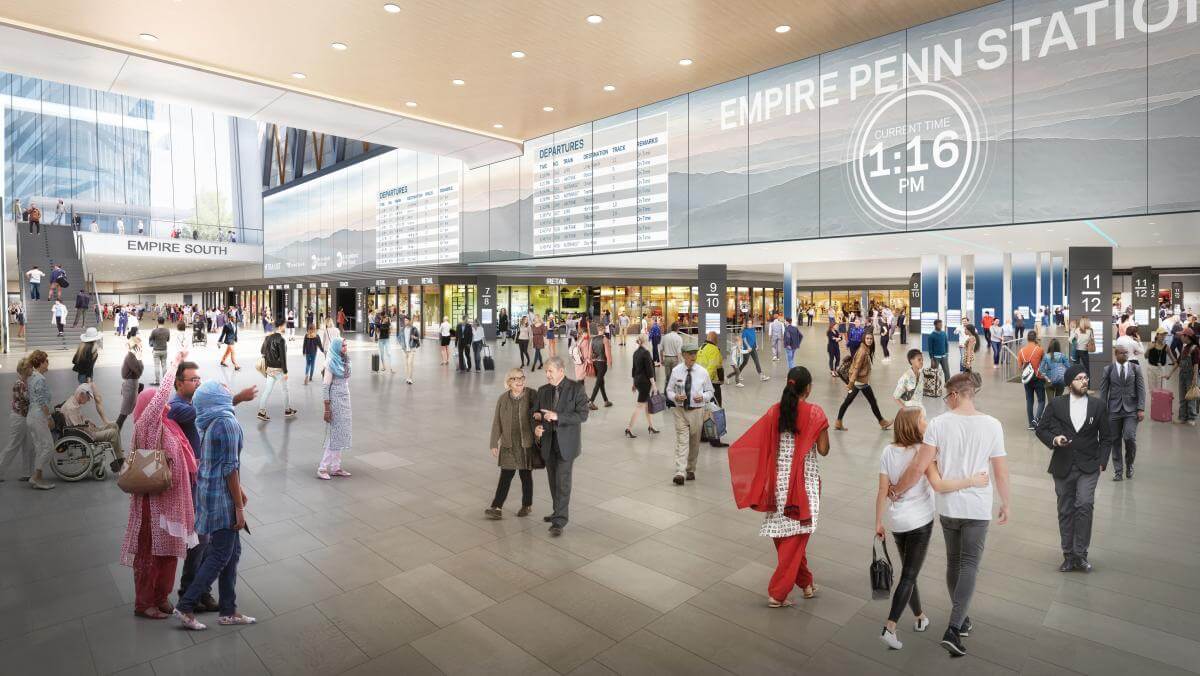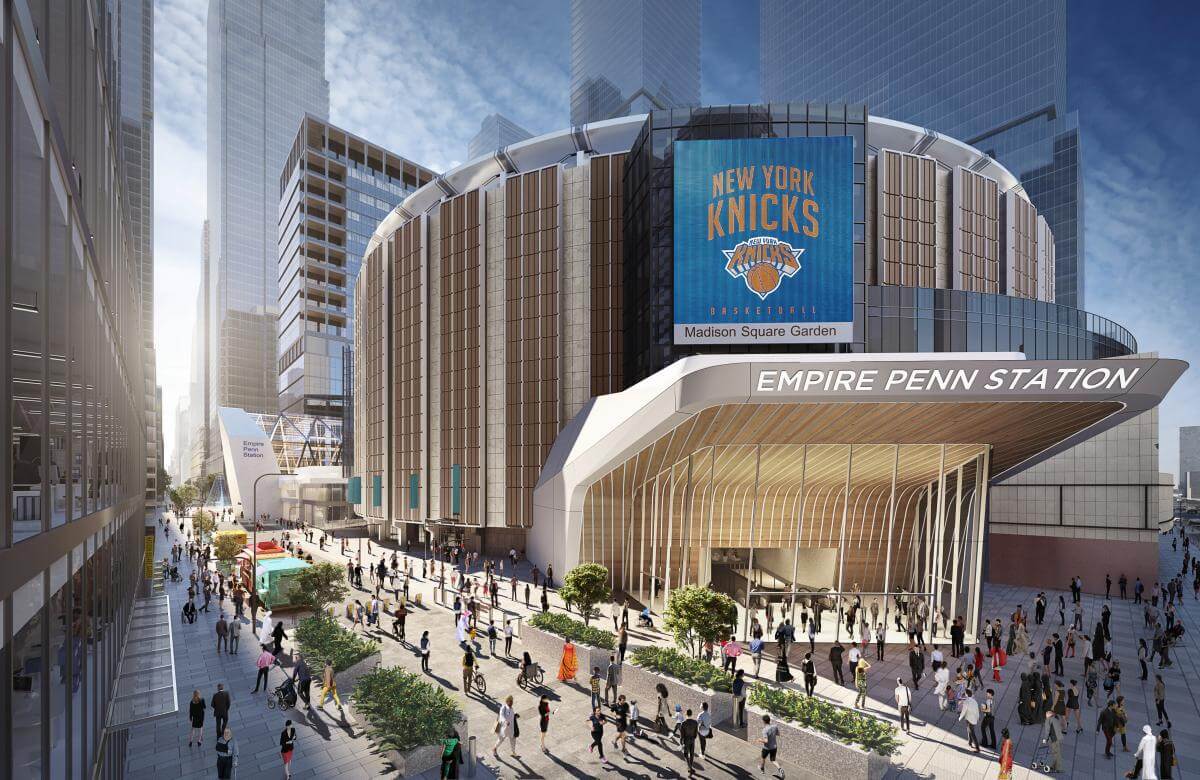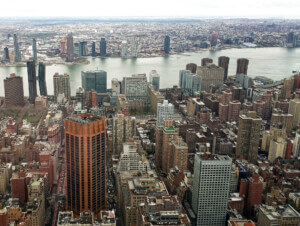A misconception held by some non-New Yorkers and those who haven’t personally descended into its cramped, confusing concourses over the last several months is that Manhattan’s Penn Station is done—closed, kaput, tossed into the dustbin of history—now that the adjacent Moynihan Train Hall is open. The train hall, a decades-in-the-making $1.6 billion adaptive reuse project led by SOM that breathes new life into McKim, Mead & White’s Beaux-Arts James A. Farley Building, does not replace Penn Station but expands and aids it, helping to relieve congestion at the world’s busiest train terminal. (During most of the day, Amtrak and Long Island Railroad passengers are now able to board at the soaring, light-filled new train hall while New Jersey Transit commuters are relegated to dank Penn station.)
This isn’t to say Penn Station will be left in its current state. As part of the Empire Station Complex, a larger reimagining of the area that controversially proposes a significant amount of demolition work to make way for a swath of vertical development spearheaded by Vornado Realty Trust, New York Governor Andrew Cuomo shared last week two reconstruction options for Penn Station. Together with Moynihan Train Hall, the new and improved Penn Station would form “an integrated, world-class public transportation rail hub for New York City.”

The reconstruction options for Penn Station, which in its current state is described as officials as being “substandard, overburdened, and aesthetically unpleasant,” follows a yearlong “strategic re-envisioning process” headed by the Metropolitan Transit Authority (MTA), Amtrak, and NJ Transit with design support from FXCollaborative and engineering firm WSP.
“The reconstruction of Penn Station will result in an interconnected, welcoming and modern station worthy of New York,” per materials provided by the MTA. “This iconic project, in combination with the new tracks and platforms to be built as part of Penn Station Expansion, will be capable of accommodating the future volume of customers using both the existing Penn Station and the newly expanded facility.” Daily ridership is expected to surge to 830,000 users in 2038, with 54 percent of them being MTA customers (the LIRR, Metro-North, and the New York City subway) and 42 percent being NJ TRANSIT customers. The remainder would be comprised of Amtrak riders.

The two alternatives revealed last week—a single-level option that would transform Penn Station into an open, airy concourse and a two-level alternative that would keep the terminal’s current configuration but dramatically improve on it—are both geared to reduce concourse congestion and accommodate future growth; unify station operations including waiting areas and ticketing booths; add more stairs, escalators, and elevators to the station’s impossibly narrow train platforms, and add new “retail opportunities” while also working in full accordance with the American with Disabilities Act.
The alternatives have now entered the early public comment stage with an Environment Impact Statement to come once an alternative is selected. (Commuters can view a full suite of renderings and share their thoughts on a new and improved single-level Penn Station versus a double-level Penn Station here.)
Preservation groups opposing the Empire Station Complex project and transportation advocacy groups were quick to weigh in on the transformative Penn Station facelift options.
In a statement, the Tri-State Transportation Campaign (TSTC) noted that a dramatically revamped Penn Station with expanded concourse space to relieve rider congestion and improved access between the concourses and the street is very much needed. However, the TSTC pointed out significant missed opportunities not addressed in the reconstruction plans: Widening the train platforms and the overall inefficiency of train operations.

As the TSTC, which recently sent Transportation secretary Pete Buttigieg a letter requesting that any forward movement on the Empire Station Complex be halted until a cost-benefit analysis of alternatives is run, elaborated:
Penn Station’s track and platform configuration, which predates the commercial airline industry, is the relic of an era when people used trains for the type of long-distance commuting that airplanes are now used for. Although this layout has not changed, today the majority of the station’s service is provided by commuter rail (NJ TRANSIT and MTA Long Island Rail Road), which has different infrastructure needs than the intercity, long-distance rail service provided by Amtrak.
A plan that aims to fundamentally transform the commuting experience should prioritize optimizing rail service for a modern through-running operation, the lynchpin of a truly unified regional rail network. We should be taking advantage of the post-COVID reduction in commuter demand to modify the existing station for through-running. Expanding Penn Station one block south for a new NJ TRANSIT terminal actually moves us farther away from unifying the rail network and creates a major limitation for expanding rail service between New York and New Jersey–the exact ridership that is projected to have the most future demand.
The Empire Station Coalition has also reacted to the Cuomo-presented reconstruction options.

Comprised of a group of civic and transportation advocacy organizations (the TSTC, City Club of New York, and Historic Districts Council among them), the coalition is ultimately supportive of plans to improve Penn Station and carry out associated redevelopment projects in the area provided that these plans unify the regional rail network and, at the same time, preserve existing historic buildings in the vicinity of Penn Station and avoid egregious demolition work. The Penn Station reconstruction alternatives, while certainly attractive and accompanied by eye-catching renderings, fail to address the core transportation issues. Instead, as the Coalition sees it, the proposals focus largely on aesthetics and passenger circulation, which, while important, don’t get to the heart of what’s needed to really improve Penn Station.
As spelled out in a statement, the Coalition’s concerns largely echo those of the TSTC:
“The station’s core transportation issues are barely addressed at the track and platform level. Despite increasing concourse space, the Governor’s plan maintains the station as an inefficient terminal with platforms still too narrow to accommodate passengers waiting for trains as they do at most other major rail hubs. The Governor refuses to consider implementing a through-running operation, which is the modern international standard for cities of this size. Penn Station’s capacity issues can be solved without needless demolition of the neighborhood. Turning Penn into a through-running station would provide the golden opportunity to finally unify the region’s commuter railroad networks and establish greater regional connectivity outside of Manhattan, including Newark, New Jersey and Long Island City, Queens.”
Adds the Coalition in a statement: “The public is increasingly aware that behind all of the glamour, Governor Cuomo’s glassy plan amounts to little more than putting ‘lipstick on a pig’ and completely misses the opportunity to transform the city and region for the better. ”

“Why New York State would choose this path when truly transformative and superior options for the future exist is hard to fathom,” said Lynn Ellsworth, chair of Human Scale-NYC, a member group of the coalition. “The fate of Penn Station, especially as the epicenter for a unified regional transit network, is the most important land-use decision in at least 75 years for New York City. The renderings released yesterday are the tip of a very dangerous iceberg and all who care about New York should do everything they can to halt this terrible threat to our future as a world-class livable city.”
As mentioned, the MTA, Amtrak, and NJ TRANSIT are now considering public input before selecting a final reconstruction Penn Station plan.











